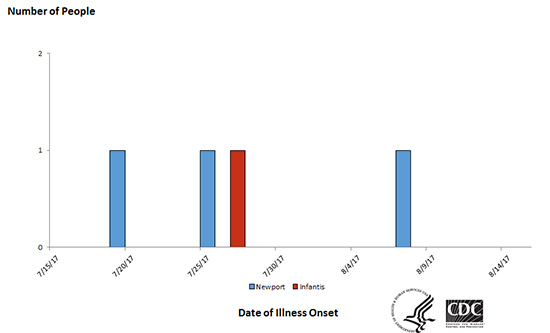2017 Salmonella Newport and Salmonella Infantis Infections Linked to Imported Maradol Papayas (Final Update)
Posted November 3, 2017 3:00 PM ET
This outbreak appears to be over. This outbreak was one of four separate multistate outbreaks identified in 2017 linked to imported Maradol papayas from four different farms in Mexico. For information on the other outbreaks, please visit the Reports of Salmonella Outbreak Investigations from 2017 webpage.
- Read the Advice to Consumers, Restaurants, and Retailers>>
- This outbreak appears to be over.
- CDC, public health and regulatory officials in several states, and the U.S. Food and Drug Administration investigated a multistate outbreak of Salmonella infections.
- Epidemiologic and laboratory evidence indicated that the likely source of this outbreak was Maradol papayas from Rancho El Ganadero farm, distributed by Caraveo Produce in Colima, Mexico.
- This outbreak included two types of Salmonella: Newport and Infantis. The same strains of these types of Salmonella were found in samples collected from papayas and from ill people.
- Four people infected with the outbreak strains of Salmonella Newport (three) or Salmonella Infantis (one) were reported from four states.
- Illnesses started on dates ranging from July 19, 2017 to August 7, 2017.
- Two ill people were hospitalized. No deaths were reported.
Introduction
CDC, public health and regulatory officials in several states, and the U.S. Food and Drug Administration (FDA) investigated a multistate outbreak of Salmonella Newport and Salmonella Infantis infections linked to imported Maradol papayas from the Rancho El Ganadero farm in Colima, Mexico that were distributed by Caraveo Produce in Colima, Mexico.
Public health investigators used the PulseNet system to identify illnesses that may have been part of this outbreak. Four people infected with the outbreak strains of Salmonella Newport (three) and Salmonella Infantis (one) were reported from four states. A list of the states and the number of cases in each can be found on the Case Count Map page. Whole genome sequencing (WGS) showed that isolates from people infected with Salmonella were closely related genetically. This close genetic relationship means that people in this outbreak were more likely to share a common source of infection.
Illnesses started on dates ranging from July 19, 2017 to August 7, 2017. Ill people ranged in age from 40 to 82, with a median of 63. Two (50%) were female. Two (50%) of the four ill people were of Hispanic ethnicity. Two (50%) of the four ill people were hospitalized. No deaths were reported.
WGS did not identify antimicrobial resistance genes in isolates from four ill people and one papaya. Standard antibiotic susceptibility testing methods were used by CDC’s National Antimicrobial Resistance Monitoring System (NARMS) laboratory on a clinical isolate from one ill person in this outbreak. This isolate also was not resistant to any antibiotics tested.
Investigation of the Outbreak
Epidemiologic and laboratory evidence indicated that imported Maradol papayas from Mexico were the likely source of this multistate outbreak.
In interviews, ill people answered questions about the foods they ate and other exposures in the week before they became ill. All three (100%) people interviewed reported eating papayas. This proportion was significantly higher than results from a survey [PDF – 29 pages] of healthy Hispanic people in which 22% reported eating papayas in the week before they were interviewed during the summer months.
As a result of this summer’s outbreak investigation linked to papayas, FDA increased testing of papayas from Mexico to see if papayas from other farms were contaminated with Salmonella. Through this increased testing, FDA identified Salmonella Newport and Salmonella Infantis on papayas from Caraveo Produce in Tecomán, Colima, Mexico that were grown by Rancho El Ganadero. Investigators compared pulsed-field gel electrophoresis (PFGE) and WGS results of Salmonella isolates from the papayas to isolates from ill people in the CDC PulseNet database. These results showed the Salmonella Newport and Salmonella Infantis isolates from papayas shared the same DNA fingerprint as the Salmonella isolates from ill people. This result provided more evidence that people in this outbreak got sick from eating contaminated Maradol papayas.
FDA reported that the shipment of contaminated papayas was destroyed and was not distributed for sale in the United States. Papayas from this farm were distributed in the United States earlier in the summer, but FDA reported that no shipments of papayas from this farm were on the market in the United States when the outbreak was identified because the papayas were past their shelf life.
This outbreak appears to be over. This outbreak was one of four separate multistate outbreaks identified in 2017 linked to imported Maradol papayas from Mexico. For information on the other outbreaks, please visit the Reports of Salmonella Outbreak Investigations from 2017 webpage.


